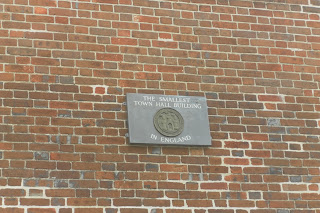We came across Corfe Village, which is dominated by a magnificent set of ruins - Corfe Castle.
Now owned by the National Trust, it was apparently used as inspiration by Enid Blyton for one of her Famous Five novels - Five on Kirrin Island Again. The NT cafe has an excellent view over looking the castle, and it was here that we sat and watched the morning go by, slowly coming round with the help of large amounts of tea.
Set in the shadow of the castle is a picture postcard example of an English village. With parts of it dating to the medieval period, it is a hotch-potch of beautiful little cottages constructed of local Purbeck limestone, lining two main streets.
Half of the buildings are listed.
If you look closely, you can see the ruins through the lamp-post in the above image.
The church was re-built in 1876, but the architect re-used parts of the 15th C medieval fabric.

It has the smallest, and possibly the cutest, town hall in the country:
Constructed half in brick (flemish design) and half in rubble stone, it is absolutley tiny, illustrating the amount of people it was built for was very small. You could not fit the village population in today! It is listed as GII* and is seventeenth century in origin, although it was largely re-built in 1774.
The village is absolutley beautiful, definitley worth a visit if you are passing through.


























